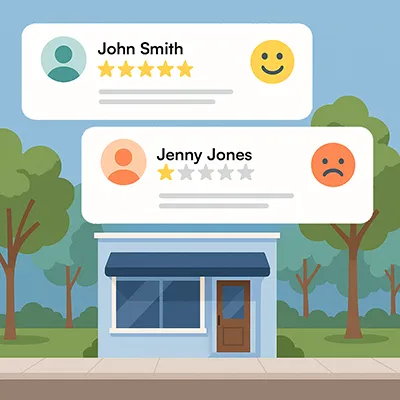Once upon a time, your front door was just that — a door. People walked or drove by, looked in the window, and decided whether or not to step inside. But in 2025, that moment of decision almost always happens online.
And more often than not, it begins with a search on Google Maps.
Whether someone’s looking for a new breakfast spot, a yoga studio, or a reliable contractor, their first interaction with your business is likely through your Google Business Profile — that little card that pops up with your name, address, star rating, and reviews.
That card is your new front door.
Showing Up Where It Counts: Optimizing for Google Maps
When someone opens the Google Maps app and types in “coffee shop” or “plumber,” they’re not just browsing — they’re actively looking to take action. These searches are often high-intent and hyper-local, and how you show up in those results can make or break that next customer interaction.
But showing up in Google Maps isn’t automatic — it’s driven by a combination of factors tied to your Google Business Profile and your local SEO footprint.
Here’s how to improve your visibility in Google Maps:
- Claim and verify your Google Business Profile - If you haven’t already done this, it’s step one. Make sure your business is claimed, verified, and accurate.
- Ensure your location is pinned correctly - Double-check that your address is listed properly and your map marker is in the right spot. A mismatched address or incorrect placement can confuse users — and the algorithm.
- Use consistent NAP data - Your Name, Address, and Phone Number (NAP) should be exactly the same across your website, GBP, directories, and social channels. Inconsistencies can hurt trust and ranking.
- Add relevant categories and keywords - Choose the right primary business category (e.g., “Hair Salon” vs. “Beauty Services”) and support it with relevant services or specialties in your description.
- Include high-quality photos - Businesses with fresh, appealing images tend to earn more clicks and engagement on Maps.
- Encourage reviews that mention location or services - Google often highlights reviews that reinforce relevance to the searcher’s query — like “Best brunch spot in Santa Rosa” or “Fast response for emergency plumbing.”
Maps results are heavily influenced by proximity, but relevance and credibility still play a huge role. The more complete and consistent your information, the better your chances of showing up when nearby customers are looking.
Star Ratings: Small Numbers, Big Impact
Here’s a number that should make every business owner pay attention:
Businesses with a 4.5+ star rating earn over 30% more clicks than those with lower ratings.
(Source: BrightLocal)
Online ratings act as social proof, and most consumers use them as a shortcut for decision-making. The difference between 3.8 and 4.6 stars might not seem dramatic — but it absolutely is.
Higher ratings can:
- Improve your position in Google’s local rankings
- Increase click-through rates on your listing
- Give hesitant customers the nudge they need to choose you over a competitor
And while you can’t (and shouldn’t) try to game the system, you can influence your reputation in authentic, ethical ways.
How to Collect More Positive Reviews — Without Being Pushy
If you’ve ever struggled to get customers to leave reviews, you’re not alone. People are far more likely to post a review after a negative experience unless you give them a simple, frictionless opportunity to share something positive.
Here are some non-intrusive ways to ask for reviews:
- Include a brief, direct ask at the end of a service: “If you enjoyed your visit, we’d really appreciate a quick review on Google — it helps more than you know.”
- Add a QR code at checkout or on receipts that links to your Google review page
- Follow up with a short email thanking the customer and including a review link
- Train staff to recognize especially happy customers and invite them personally
The key is to make it easy and timely. Most satisfied customers are happy to support you — they just need a small prompt.
Dealing with Negative Reviews (Without Going on the Defensive)
No matter how great your service is, bad reviews happen. What matters most is how you respond.
Potential customers don’t expect perfection. What they do expect is professionalism, accountability, and a willingness to listen.
Here’s how to approach it:
- Respond quickly — ideally within 24–48 hours
- Stay calm and courteous, even if the review is unfair
- Acknowledge their experience without necessarily admitting fault:
“We’re sorry to hear your visit didn’t go as expected…” - Offer to take the conversation offline:
“We’d love to learn more — feel free to reach out directly at [email or phone].” - Don’t argue. The goal isn’t to “win” the exchange — it’s to demonstrate that you care and are listening
Remember: You’re not just replying to that one customer — you’re showing everyone else how you handle conflict.
Final Thoughts
In the modern marketing landscape, your Google listing and reviews can be just as influential as your website or storefront. They offer a snapshot of your reputation — and often determine whether a potential customer ever walks through your door in the first place.
Managing your profile, building a base of positive reviews, and responding to feedback with care isn’t just good PR — it’s smart business.





